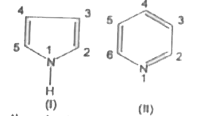The amino group when attached to the ring makes it highly activating towards electrophilic substitution. Consequently, the electrophilic substitution readily takes place in aniline at all the three ortho and para positions. However on acetylation with acetyl chloride the activation of the ring to amino group is sufficiently reduced and the electrophilic substitution in benzene ring takes place preferably at the para position which is less hindered than the ortho position.
3, 5 dibromotolyene can be best synthesised by
A

B

C

D

Text Solution
The correct Answer is:B
−NH2 group being more activating than CH3 group, will lead to bromination at the ortho position.

|
Topper's Solved these Questions
- CYANIDES, ISOCYANIDES, NITROCOMPOUNDS AND AMINESBOOK - DINESH PUBLICATIONCHAPTER - CYANIDES, ISOCYANIDES, NITROCOMPOUNDS AND AMINESEXERCISE - Matrix type
6 Videos
- CYANIDES, ISOCYANIDES, NITROCOMPOUNDS AND AMINESBOOK - DINESH PUBLICATIONCHAPTER - CYANIDES, ISOCYANIDES, NITROCOMPOUNDS AND AMINESEXERCISE - INTEGER TYPE
9 Videos
- CYANIDES, ISOCYANIDES, NITROCOMPOUNDS AND AMINESBOOK - DINESH PUBLICATIONCHAPTER - CYANIDES, ISOCYANIDES, NITROCOMPOUNDS AND AMINESEXERCISE - Selected Straight Objective Type MCQs
50 Videos
- CO-ORDINATION COMPOUNDS BOOK - DINESH PUBLICATIONCHAPTER - CO-ORDINATION COMPOUNDS EXERCISE - Brain storming multiple choice question
12 Videos
- D-AND -F BLOCK ELEMENTSBOOK - DINESH PUBLICATIONCHAPTER - D-AND -F BLOCK ELEMENTSEXERCISE - BRAIN STORMING MULTIPLE CHOICE QUESTIONS (MCQS)
13 Videos
Similar Questions
Knowledge Check
The amino group when attached to the ring makes it highly activating towards electrophilic substitution. Consequently, the electrophilic substitution readily takes place in aniline at all the three ortho and para positions. However on acetylation with acetyl chloride the activation of the ring to amino group is sufficiently reduced and the electrophilic substitution in benzene ring takes place preferably at the para position which is less hindered than the ortho position.
Towards electrophilic substitution, most reactive will beANitrobenzeneBAnilineCAniline hydrochlorideDN acetylamine.The amino group when attached to the ring makes it highly activating towards electrophilic substitution. Consequently, the electrophilic substitution readily takes place in aniline at all the three ortho and para positions. However on acetylation with acetyl chloride the activation of the ring to amino group is sufficiently reduced and the electrophilic substitution in benzene ring takes place preferably at the para position which is less hindered than the ortho position.
Which of the following reagent is used to distinguish between
 ADilute HClBC6H5SO2Cl and OH−/H2OCHONO and β-naphtholDAgNO3 (aqueous solution).
ADilute HClBC6H5SO2Cl and OH−/H2OCHONO and β-naphtholDAgNO3 (aqueous solution).Which of the following substituents deactivates the benzene ring towards electrophilic substitution?
A−CHOB−NR2C−NHCOCH3D−NO2
Explain how does the −OH group attached to a carbon of benzene ring activate it towards electrophilic substitution?
View SolutionThe most deactivating group for electrophilic substitution reaction in benzene ring is
View SolutionIn the following compounds

the electrophilic substitution in the ring take place at _____positions respectively
View SolutionWhich of the following group activates the benzene ring most towards electrophilic substitution
View SolutionWhich of the following froups groups deactivates the benzene ring towards electrophilic substitution ?
View Solution
